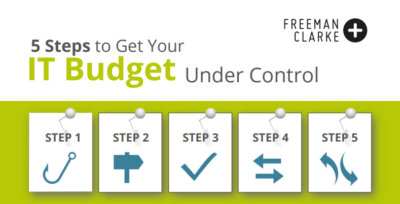Infographic: 5 steps to get your IT budget under control
To download, save or print this Infographic, click here
Read moreTo download, save or print this Infographic, click here
Read moreLet’s start with a definition. For us, digital transformation means using IT and technology to dramatically change your business for...
Read moreA Chief Information Security Officer is a senior-level executive responsible for protecting your data and intellectual property, and your information...
Read moreFor mid-market businesses, hiring the right people is always a challenge. In today’s employment market, it can be near-impossible. Not...
Read moreAn Enterprise Resource Planning (ERP) project is when you integrate all your company’s core processes into a single system—finance, HR,...
Read moreAn Enterprise Resource Planning (ERP) project is when you integrate all your company’s core processes into a single system—finance, HR,...
Read moreMany companies wonder about the benefits of using a digital strategy consultant, a role often fulfilled by an experienced CIO...
Read moreWhy should your business have a Fractional CIO? The Chief Information Officer (CIO) is a crucial role in a business,...
Read moreCIO stands for "Chief Information Officer." It's a C-suite position responsible for technology, staff, and suppliers. CIOs also oversee systems,...
Read morePlain English board-level briefings focused on technology strategies to deliver competitive advantage and business success.
You can unsubscribe at any time.
Call us on 0203 020 1864 with any questions.
Graeme Freeman
Co-Founder and Director
Plain English board-level briefings focused on technology strategies to deliver competitive advantage and business success.
You can unsubscribe at any time.
Call us on 0203 020 1864 with any questions.








